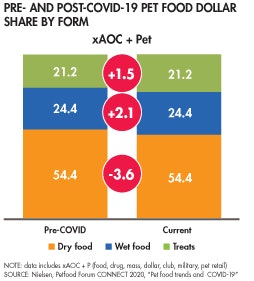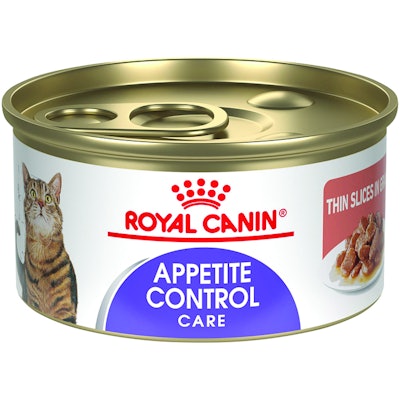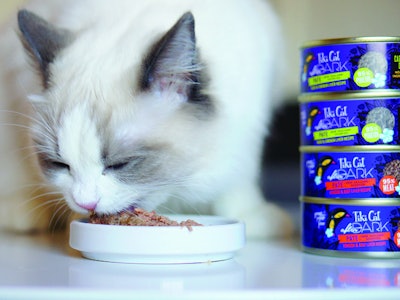
Wet pet food saw some interesting numbers in 2020. The U.S. side of the segment saw the same jump in sales that dry pet food and treats did in March, when initial COVID-19 pandemic lockdowns took place and pet owners everywhere stocked up and hunkered down. Unsurprisingly, the wet segment rebounded more quickly than dry because supplies of dry pet food lasted longer in customer pantries. By the beginning of August, according to data presented by Sean Simpson, associate client director at Nielsen Global Connect, during Petfood Forum CONNECT in September, dry pet food sales were still down while wet sales were almost back to January 2020 levels.
More interestingly, however, between April and August wet food dollar share gained ground — 2.1 points, according to Nielsen data — while dry food lost 3.6 points (see Figure 1).

FIGURE 1: The wet pet food segment saw an uptick in dollar share in 2020, as the COVID-19 pandemic caused multiple shifts in the space.
Why does wet food continue to grow in appeal?
The events of 2020 may have given wet pet food a bit of a boost into the spotlight, as pet owners stayed home and paid more attention than ever to what their furry friends were eating every day. A segment that may have seemed a bit more time intensive or less convenient has shed some of that stigma in the last year.
“Convenience is less of an issue now that more people work from home, so wet can be fed exclusively instead of as an infrequent treat,” said Ann Hudson, vice president of marketing for Whitebridge Pet Brands LLC and the Tiki Cat/Tiki Dog brands. “The wet category will continue to grow because it is better for the pet, takes less space in the store and owners like it. The initial commitment to purchase is lower and if you feed a diet that is nutrient-dense, with low carbs and high protein, it can be affordable.”
And while more traditional forms of wet food still reign in the segment — in a July 2020 Packaged Facts consumer survey, 66% of cat owners and 49% of dog owners said they use wet or moist pet food in cans or pouches to feed their pets — premium and superpremium options such as refrigerated or frozen food continue to carve out share. In fact, according to Nielsen data, while shelf-stable wet food saw negative or flat year-over-year dollar growth in the early months of COVID-19 across all channels, refrigerated pet food stayed positive throughout all of 2020 in the xAOC space (which includes food, drug, mass, dollar, club and military). In the pet retail space, refrigerated took longer to recover, but frozen pet food remained positive.
Perhaps pet owners, who were paying more attention to their own food in 2020, were also looking to liven up their pets’ bowls.
“Cats and dogs taste more than just flavor,” said Catherine Lenox, DVM, regulatory veterinary manager for Royal Canin. “They are naturally drawn to a combination of the right nutrient balance as well as texture, aroma, shape, size (this would apply to chunks in wet food) and flavor. While this is especially true for cats, it can be true for dogs, too.” In a time when humanization of pets has already reached its peak and pets are suddenly 24/7 companions with everyone working remotely and otherwise staying home, it makes sense that more notice would be taken of mealtimes.
New products and 2021 wet pet food trends
Health and nutrition seem to be key words in 2021 wet pet food, a combination of growing customer desires for personalized pet nutrition and COVID-19-related focus on health and wellness in both the human and pet spaces overall.
In October 2020, Chicken Soup for the Soul Pet Food introduced a new line of wet dog foods, Cuts in Gravy, highlighting a nutrition focus as well as a diverse ingredient panel to appeal to pet owners. The three formulas, which include beef, turkey or chicken as the first ingredient, also include fruits and vegetables such as blueberries, cranberries, sweet potatoes and carrots. The natural dog food also has omega-3 and -6 fatty acids to help with skin and coat health, one of the key functional claims pet owners often look for.
Weight management is another health trend in pet food, and Royal Canin, which operates heavily in the veterinary space, is poised to meet this particular need.
“Because of the associated health risks, veterinarians and pet owners are showing an increased concern about weight gain in pets, driving a trend toward development of weight management products, including lower-calorie wet food or wet food with other benefits to help promote weight management in pets,” said Lenox. “One example of a product meeting this trend is a new Royal Canin product, Feline Care Nutrition Appetite Control Care Thin Slices in Gravy.” The product helps cats maintain a healthy weight while reducing the feeling of hunger using a special fiber blend, helping to keep them feeling full and reducing their tendency to beg.

Royal Canin is well known in the health and wellness pet space; the company recently released a new product aimed at pet obesity, a top pet health concern among both veterinarians and pet owners. | Courtesy Royal Canin
And naturally, as options continue to grow, it behooves brands to ensure their products don’t get overlooked or caught up in customer confusion. According to Hudson, that means making it easier to shop.
“Tiki competes in the ‘premium natural’ category and that is where we belong in the store,” said Hudson. “We want to work with retailers to effectively merchandise their sets to reflect this evolution.”
Even prime placement in a store, however, might not be enough to seal the deal if pet owners don’t understand what you’re selling.
“Cans are small and hard to read so we need to look at new and different ways to package and merchandise wet that includes more label space for information,” said Hudson. “We are launching Tiki Dog ‘soda-pack’ options for large cans of dog food, in both variety-pack and multi-pack assortments. Boxes optimize shelf space and provide the space to tell a story. We have [also] added a picture of the food to all our wet labels so consumers know exactly what they are getting.”

Tiki Cat has aimed to make its wet foods even more appealing on the shelf; among the updates are showing pictures of the food on all canned labels. | Courtesy Tiki Cat
Finally, wet pet food needs to really find its place in consumer minds as a full and complete food option, rather than a treat or occasional meal.
“Wet food is not just a treat for cats and dogs,” said Lenox. “It provides complete and balanced nutrition and has other benefits such as promoting healthy hydration and helping pets feel full. There are distinct benefits to feeding wet food, either by itself or combined with dry food.”

















